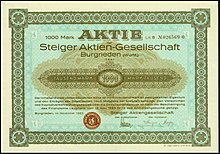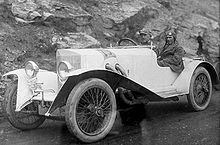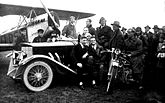Steiger (automobile manufacturer)
| Steiger AG
|
|
|---|---|
| legal form | Corporation |
| founding | 1914 (as machine factory Walther Steiger & Co. ) |
| resolution | 1926 |
| Reason for dissolution | insolvency |
| Seat | Burgrieden , Germany |
| management | Walther Steiger |
| Number of employees | up to 500 |
| Branch | Motor vehicle manufacturer |
Steiger was a German company which in 1914 by the Swiss engineer Walther Steiger in Burgrieden in Laupheim as Maschinenfabrik Walter Steiger & Co. was founded. In 1921, there was a public limited company under the company Steiger AG converted. In the short period of its existence, around 3,500 passenger and sports cars were produced.
Beginnings
During the First World War , aircraft and aircraft engines were repaired at Steiger . From 1917 the owner and his designer Paul Henze were already working with motor vehicles. Originally they planned to manufacture farm tractors , but soon switched to the development of passenger cars. The first model, the Steiger 10/50 PS , came out in 1918 . The touring car with a 2.6-liter four-cylinder engine and 37 kW (50 hp) was also the most important model, which was also offered until the company collapsed in 1926. The special feature of its modern OHC engine consisted of an optional switchable dual ignition and a vertical shaft that drove the overhead camshaft via spiral-toothed bevel gears . The vehicles with a U-profile pressed steel frame, two leaf-sprung rigid axles and a pointed radiator were considered to be the most technically remarkable new creation at the beginning of the 1920s and the most progressive German production cars of their time .
Short flowering
From 1921 own bodies were also manufactured. In 1922 a two-seater roadster with a larger engine (2.8 l displacement , output 40 kW / 55 PS) came out, which was delivered from 1924 in an even more powerful version (2.9 l displacement, output 51 kW / 70 PS). The vehicles reached a top speed of at least 140 km / h (100-hp racing versions were up to 180 km / h) and cost 18,000 Reichsmarks . In 1925 the more powerful Steiger 11/55 hp touring car appeared with an extended wheelbase and the engine of the first sports car. The high-performance sports and racing versions were successful in numerous car races ( Solitude , AVUS , Eifelrennen , Klausenrennen , Monza , Targa Florio ) in the 1920s .
At times the company employed up to 500 workers and employees. Despite their high-quality products, which have been compared to Bugatti in many ways , the company had to file for bankruptcy in the wake of the automotive crisis in 1926. By then around 3,500 vehicles had been built.
- Steiger automobiles
Car models
| Type | Construction period | cylinder | Displacement | power | V max |
|---|---|---|---|---|---|
| Steiger 10/50 HP | 1920-1926 | 4 row | 2604 cc | 37 kW (50 PS) | 95 km / h |
| Steiger Sport 11/55 PS | 1922-1924 | 4 row | 2826 cc | 40 kW (54 PS) | 128 km / h |
| Steiger Sport 12/70 PS | 1924-1926 | 4 row | 2902 cc | 51 kW (69 hp) | 140 km / h |
| Steiger 11/55 hp | 1925-1926 | 4 row | 2826 cc | 40 kW (54 PS) | 100 km / h |
Steiger martini
After the liquidation of his company, Walther Steiger went to the Swiss automobile manufacturer Martini , in which he and his brother Robert had held the majority of the shares since 1924. a. a 70 kW (95 PS) six-cylinder model . The luxurious car with a 4.4-liter engine, which came onto the market in Switzerland as the Martini-Six , was offered in Germany under the name Steiger-Martini 17/100 PS .
As before with Steiger, various racing versions were developed at Martini, some of which achieved spectacular successes (e.g. two first four places in the Klausen race in 1929). In the long run, however, the vehicles, which were carefully produced individually, could not hold their own against the increasingly cheaper large-scale competition from Germany, France and the USA. The end of the traditional brand was inevitable, on June 12, 1934 the last Martini left the factory in Saint-Blaise on Lake Neuchâtel .
literature
- Ferdinand Hediger, Hans-Heinrich von Fersen, Michael Sedgwick: Classic Cars 1919–1939 . Hallwag, Cologne 1994, ISBN 3-8228-8944-X .
- Michael Schick: Steiger. The story of a Swabian car factory in the 1920s. Self-published , Laupheim 1999, ISBN 3-00-003913-9 (2nd edition 2017, ISBN 978-3-00-055314-1 ).
Web links
- Steiger Automobilbau Burgrieden. "The history of a Swabian car factory" online for reading. steiger-burgrieden.de, accessed on April 29, 2013 .
- Video: "The most fascinating cars in the world - classics" (auto motor und sport-tv) / DVD 2002 EAN 4-260000-950484
Individual evidence
- ↑ https://www.gtue-oldtimerservice.de/automobil/marke/STEIGER/832/
- ↑ Hans-Heinrich von Fersen, Dieter Korp: Cars in Germany 1920-1939 . 2nd Edition. Motor-Presse-Verlag, Stuttgart 1964, p. 300 .
- ↑ Werner Oswald : German Cars 1920–1945 . tape 2 . Motorbuch-Verlag, Stuttgart 2005, ISBN 3-613-02170-6 , p. 358 .
- ^ Klausenrennen Ranking 1923, category touring cars. klausenrennen.com, accessed April 29, 2013 .
- ↑ a b Michael Schick: Steiger. The history of a Swabian car factory in the 20s . Self-published, Laupheim 1999, ISBN 3-00-003913-9 , p. 58, p. 67 .
- ^ Ferdinand Hediger: Oldtimer. Interesting automobiles from 1885–1939 . 3. Edition. Hallwag, Bern, Stuttgart 1982, ISBN 3-444-50134-X , p. 46 f .
- ↑ Ralf JF Kieselbach, Hans-Erhard Lessing: Fascination of form. Automobile design in Baden-Württemberg . Metzler, Stuttgart, Weimar 2002, ISBN 3-476-01825-3 , pp. 78 .
- ^ Uta Jung, Helmut Jung: Stuttgarter Karosseriewerk Reutter, founded in 1906 . From the reform body to the Porsche 356.Delius Klasing, Bielefeld 2006, ISBN 3-7688-1829-2 , p. 86 f., (with 3 pictures).
- ↑ Klausenrennen Ranking 1929, category touring cars & sports cars up to 5,000 cm³. klausenrennen.com, accessed April 29, 2013 .










